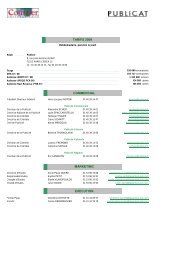2 ОРГАНИЗАЦИЯ И МЕТОДИКА РАБОТ - Courrier international
2 ОРГАНИЗАЦИЯ И МЕТОДИКА РАБОТ - Courrier international
2 ОРГАНИЗАЦИЯ И МЕТОДИКА РАБОТ - Courrier international
You also want an ePaper? Increase the reach of your titles
YUMPU automatically turns print PDFs into web optimized ePapers that Google loves.
5 ASSESSMENT OF SOIL AND GROUND POLLUTION IN THE SURVEYED<br />
AREAS<br />
5.1 Chemical-analytical characteristics of pollutant groups to be controlled<br />
Petroleum hydrocarbons<br />
Total petroleum hydrocarbons<br />
Oil and products of its processing (oil products), which are the most widely spread environmental<br />
pollutants are a complex mixture of different hydrocarbons of aliphatic (paraffinic), naphthenic and<br />
aromatic homologous series having a number of carbon atoms from 5 to 70 and organic compounds<br />
of other classes such as naphthenic acids, organic compounds of sulfur, nitrogen, etc).<br />
According to the recommendations of Russian and <strong>international</strong> technical standards, the<br />
measurement of total petroleum hydrocarbons was conducted using a method of dispersionless IR<br />
spectrophotometry allowing to efficiently monitor the total content of the most typical group of<br />
compounds comprising the main part of oil and products of its processing such as non- polar and<br />
slightly polar hydrocarbons not sorbed on active aluminum oxide.<br />
This group includes all branched and unbranched alkanes, naphthenic hydrocarbons without<br />
condensed nuclei. These types of hydrocarbons are an integral part of the natural geochemical<br />
background. Their presence in surface waters at levels of 10-50 mcg/l can be provided by both<br />
intake of oil products and the presence of hydrobiont and terrigeneous genesis biogenic lipids.<br />
The content of petroleum hydrocarbons in surface and ground waters in higher concentrations is a<br />
sign of the presence of a constant pollution source.<br />
Toxicity of aliphatic and naphthenic hydrocarbons is relatively low, however, due to their high<br />
capacity to form emulsions and surface films, their presence even in small concentrations in surface<br />
and ground waters and soils causes significant changes in oxygen metabolism, what in its turn,<br />
leads to a negative environmental effect such as mass young fish and fish embryo mortality,<br />
inhibition of plant growth, etc.<br />
Volatile aromatic hydrocarbons (VAH)<br />
Volatile aromatic hydrocarbons (VAH) such as benzene, toluene and ortho-, para-, and meta-<br />
xylenes are highly volatile compounds having high toxic properties, irritant effects and strong<br />
characteristic odor, which, due to their high solubility in water (100-800 mg/l) can impart an<br />
unpleasant odor and taste to water making it unfit to drink.<br />
Also aromatic hydrocarbons are the most toxic. Due to a the high volatility of these substances even<br />
at low temperatures, their presence in natural waters can be observed only in case the presence of a<br />
constant source of new oil products and only in close proximity to such sources only.<br />
The high volatility of this group of compounds also explains their significant toxic hazard for<br />
personnel and population through an inhalation route.<br />
When accumulating in soils in the locations of accidental oil spill or of burning of mine dumps, the<br />
rate of evaporation of VAH significantly varies leading to the increase in the time of exposure of<br />
FINAL REPORT for Contract No. CS-NPA-Arctic-13/2009 of December 01, 2009 within the framework of pilot project Development of<br />
Technology of clean up of the area of Decommissioned Sites of The Russian Federation Ministry of Defense in the Arctic by the<br />
Example of Alexanra Island of Franz Josef Land Archipelago from Hazardous Waste<br />
71








